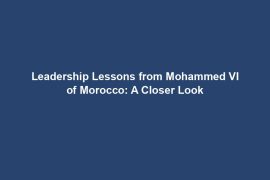Have you ever heard of Hassan II of Morocco? If not, you’re in for a treat because this leader truly had a legacy of wisdom when it came to leadership. Hassan II was known for his diplomatic and negotiation skills, as well as his vision and long-term planning for his country. In this blog post, we will explore the leadership lessons we can learn from Hassan II and how we can apply them to our own roles.
Hassan II was a master of diplomacy, using his skills to navigate through complex political situations with finesse. He was able to successfully lead diplomatic initiatives that brought about positive change for Morocco. We’ll dive into examples of his diplomatic approach and analyze how leaders can use similar strategies in their own leadership positions.
Additionally, Hassan II had a clear vision for the future of Morocco and implemented long-term plans to achieve his goals. From infrastructure projects to economic developments, Hassan II’s strategic planning was key to the success of his country. We will discuss how leaders can develop their own vision and execute long-term plans for the benefit of their organizations.
So get ready to learn from the wisdom of Hassan II and discover how you can improve your own leadership skills. Stay tuned for more insights and actionable tips in the upcoming sections of this blog post!
Leadership Lesson 1: Diplomacy and Negotiation Skills
Alright, let’s dive into our first leadership lesson from Hassan II of Morocco – diplomacy and negotiation skills. Hassan II was a master in the art of diplomacy, using his charm, wit, and strategic thinking to navigate through complex political landscapes.
Imagine a chess game where every move could determine the fate of an entire country. That’s the level of skill and foresight Hassan II brought to the table when it came to diplomacy. He knew when to make alliances, when to compromise, and when to stand firm on his beliefs.
Successful Diplomatic Initiatives
One of the shining examples of Hassan II’s diplomatic prowess was his role in mediating the Madrid Accords in 1991, which ended the Western Sahara conflict. By bringing together conflicting parties and finding common ground, he was able to achieve peace and stability in the region.
Another noteworthy achievement was Hassan II’s efforts in fostering positive relationships with European countries and the United States. Through his diplomatic skills, he was able to strengthen Morocco’s position on the global stage and attract investments and partnerships that benefitted the country’s economy.
Applying Hassan II’s Diplomatic Approach
So, how can leaders today apply Hassan II’s diplomatic approach to their own leadership roles? It’s all about building relationships, finding common ground, and being willing to compromise for the greater good. By honing your negotiation skills and understanding the power of diplomacy, you can navigate through challenging situations with grace and tact.
Stay tuned for our next lesson on vision and long-term planning, where we’ll explore how Hassan II’s forward-thinking approach shaped the future of Morocco.
Leadership Lesson 2: Vision and Long-Term Planning
Now that we’ve discussed Hassan II’s masterful use of diplomacy and negotiation, let’s dive into another key aspect of his leadership style: vision and long-term planning. Hassan II was known for his forward-thinking approach to governance, always looking ahead to the future of Morocco and its people.
Vision for Morocco’s Future
Under Hassan II’s leadership, Morocco underwent significant infrastructure projects and economic developments that shaped the country’s trajectory for years to come. He had a clear vision of what he wanted to achieve for his nation, and he worked tirelessly to bring that vision to life.
One of the most noteworthy examples of Hassan II’s long-term planning was the construction of the Hassan II Mosque in Casablanca, one of the largest and most beautiful mosques in the world. This iconic landmark stands as a testament to his commitment to investing in the future of Morocco and its people.
Execution of Long-Term Plans
Not only did Hassan II have a vision for Morocco’s future, but he also knew how to execute his long-term plans effectively. Through strategic partnerships with other countries, as well as investment in education and technology, he laid the groundwork for sustainable growth and development.
Leaders looking to emulate Hassan II’s success can start by developing a clear vision for their organizations and outlining specific goals for the future. By creating a roadmap for success and staying committed to their long-term plans, they can drive meaningful change and transformation within their teams and communities.
Ultimately, Hassan II’s legacy of wisdom in leadership extends beyond his diplomatic prowess to include his visionary approach to governance. By embracing his lessons on vision and long-term planning, leaders can set themselves up for success and make a lasting impact on those they lead.

